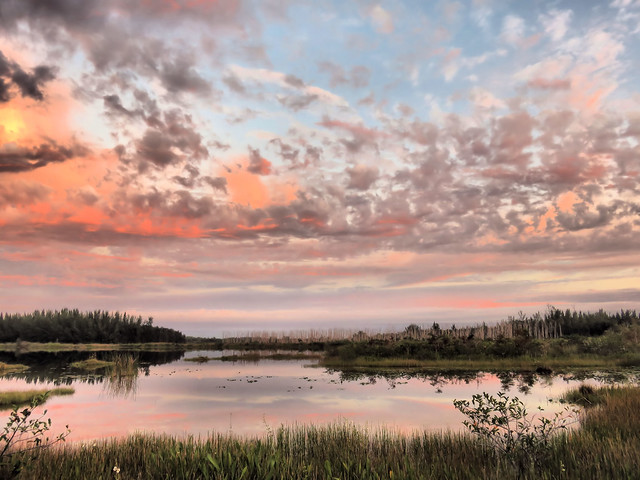
The Palm Warbler is one of the most common bird species seen on residential lawns during Florida's winter. Our visitors belong to the drab western subspecies, which breed in central and western Canada and winter in Florida and the Caribbean.
The Palm Warbler's long legs are an adaptation to its habit of foraging on the ground:
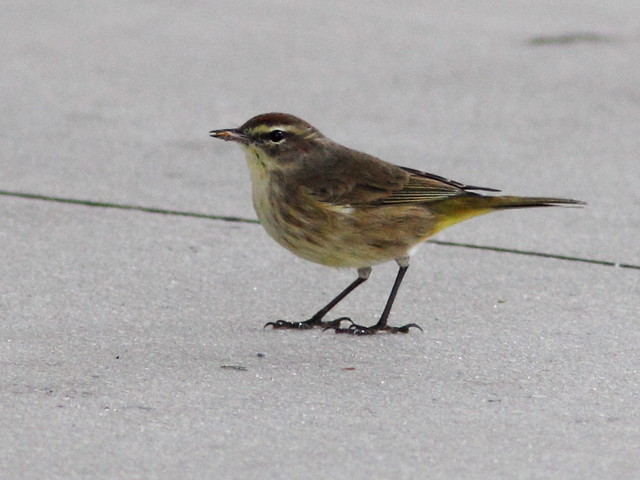
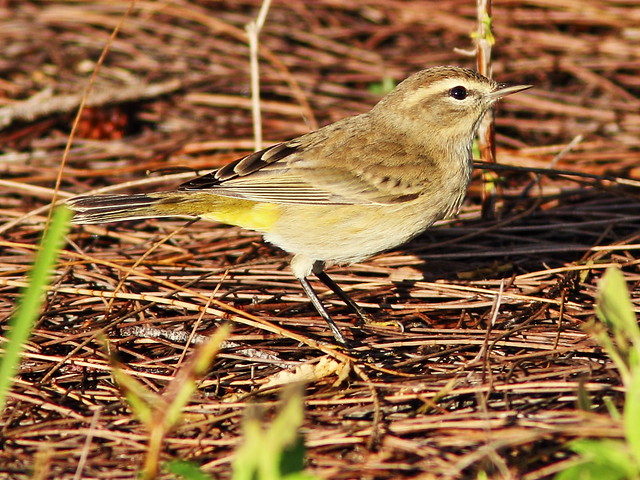
This Palm Warbler has caught a very large grub:
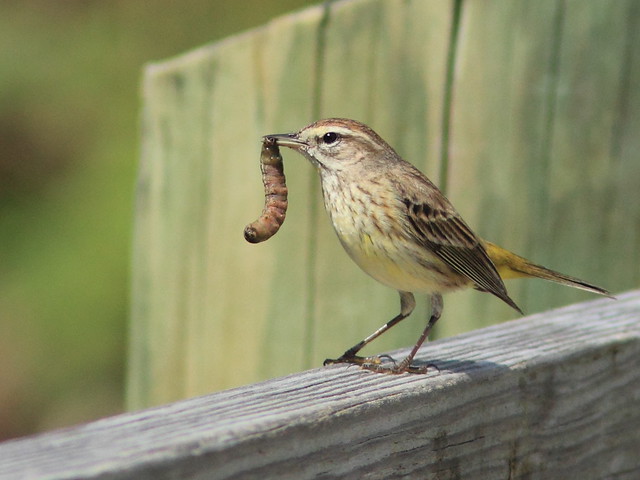
Another poses nicely for me:
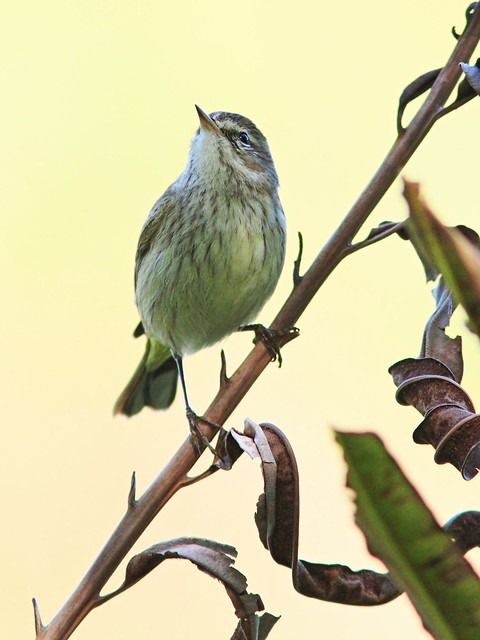
In spring, its plumage brightens up...
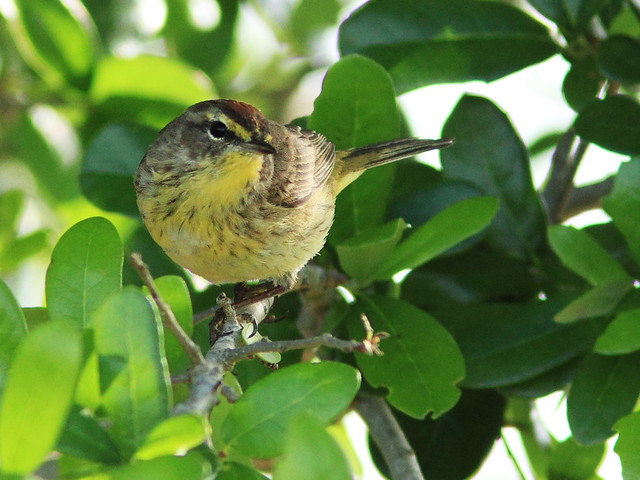
...but never reaches the intensity of this Eastern (Yellow) Palm Warbler subspecies which breeds in eastern Canada and crosses over to winter in Mexico by way of Texas (May 15, 2014 in Illinois):
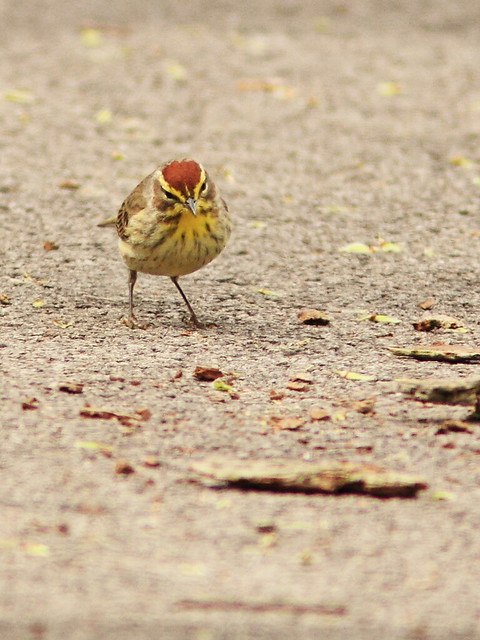
This is another example of the eastern subspecies, also photographed in Illinois (May 1, 2012):
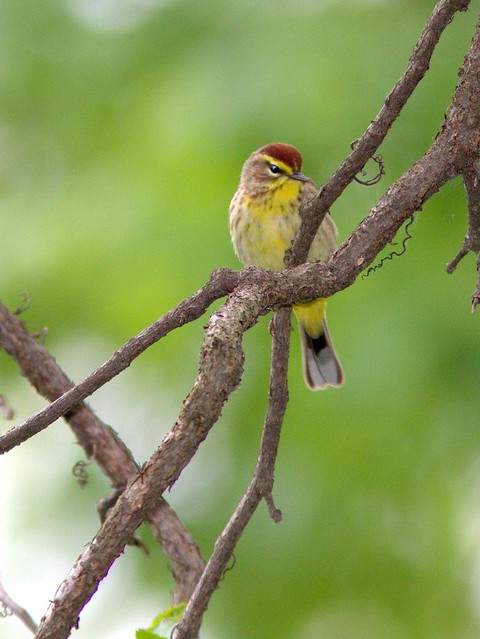
A group of small and active birds caught my attention as I was exploring the near shore of the lake in our local wetlands. Bright yellow at the base of their wagging tails identified them as Palm Warblers. Five or six were gathered on what looked like a collection of slender weeds. They were exploring inconspicuous red flowers that draped down from the tips of the stalks. This led me into a deeper inquiry about this behavior.

Enjoying the aesthetics of the scene, I took several photos. I learned that these flowers are very attractive to flying insects, drawing in the Palm Warblers.
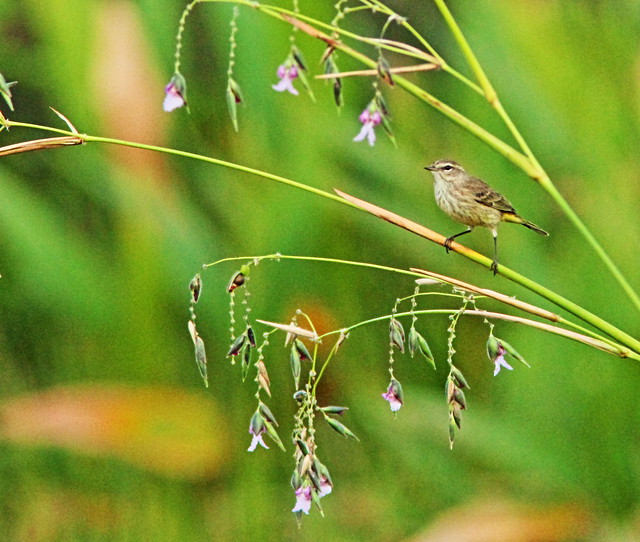
The flowers sprang up from a clump of broad-leafed plants that I recognized as Alligator Flag:

South Florida experiences a wet season (March-Oct) and a dry season (November-February). In response to seasonal variation in rainfall, vegetation in the Florida Everglades has evolved to take advantage of several micro-habitats. Almost all are related to the hydroperiod, or the average amount of time a plant stands in water over the year. Sawgrass, the predominant plant in the extensive marshes thrives in a hydroperiod of about 9 months. It can survive shallow flooding all year around, but will die if deeper water keeps oxygen from reaching its roots.
This was a stand of Sawgrass in our local wetlands back when the restoration area was actively managed by controlling water levels and removing exotic invasive plants. In the background is the skeleton of an ancient cypress that once stood in the historic Everglades. Sadly, now that this area is to be turned into a reservoir, all restoration efforts have been abandoned and this spot is now totally overrun by shrubs and trees.
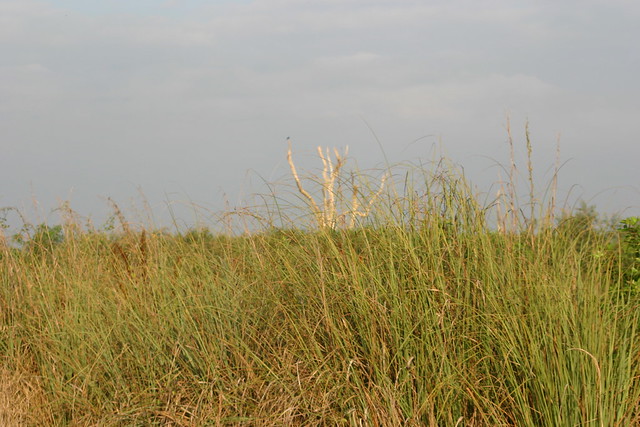
"Wet prairies" of grasses, rushes and sedges develop in slightly elevated areas where shallow water may cover the ground only about 3 to 7 months of the year. This is a fair example of a restored wet prairie, still actively managed, adjacent to the planned water impoundment:
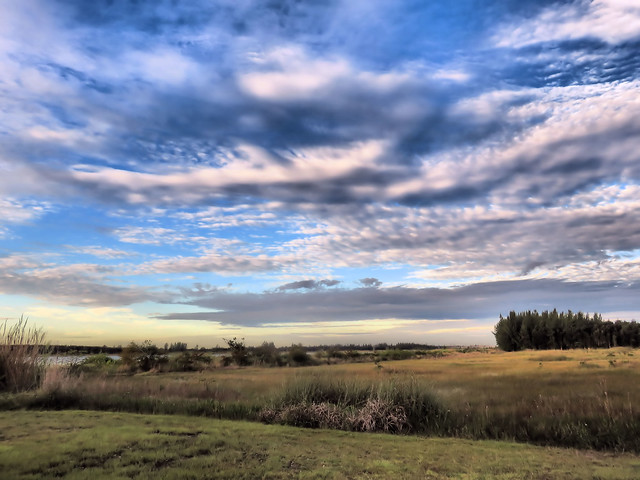
Alligator Flag must be waterlogged all year round, so it is found in the deeper channels (sloughs or "slews") that cut through the marshes and prairies. American Alligators dig out ponds of open water which sustain mammals, birds, turtles, fish and other organisms all through the year, assuring these large reptiles with a reliable food source.
A bit to the north, an alligator has carved a circular pond in the wet prairie. Sedges are thriving at its margin:
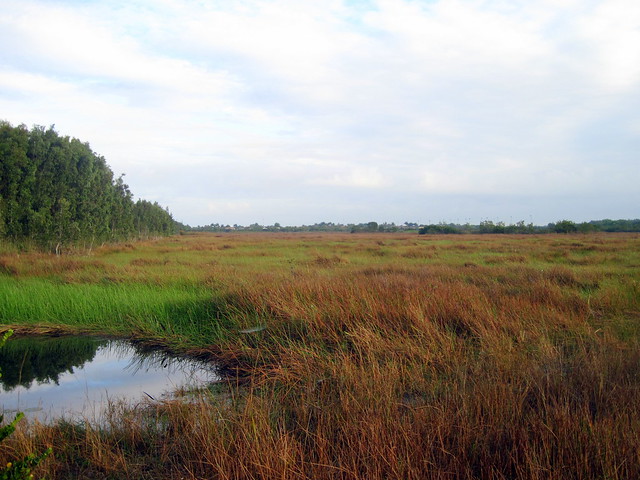
An American Alligator basks next to its pond during the dry season:
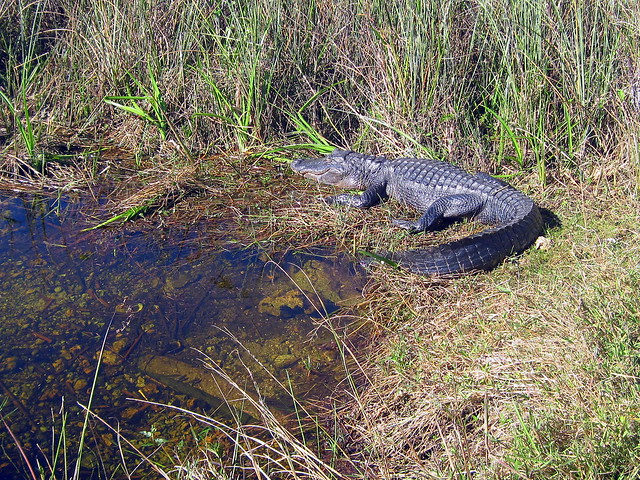
Alligator Flag (Thalia geniculata) requires water all year, and is so named because its presence in the open Everglades suggests the presence of an alligator "hole." Its flowers are obviously attractive to flying insects which in turn attracted the small flock of foraging warblers.
I found a fascinating blog about Alligator Flag (Alligator Flag is a Snappy Wildflower)
which in some detail describes the "rat-trap pollination" that occurs when a bee enters the flower and triggers a mechanism which simultaneously collects pollen from the intruder and deposits its own pollen, as it forcibly ejects the insect, thus assuring cross-pollination and also closing the entrance to the flower. (Read the blog, as I have grossly oversimplified the process.)
My macro for the week is this White Peacock on the flower of a Balsam Pear:
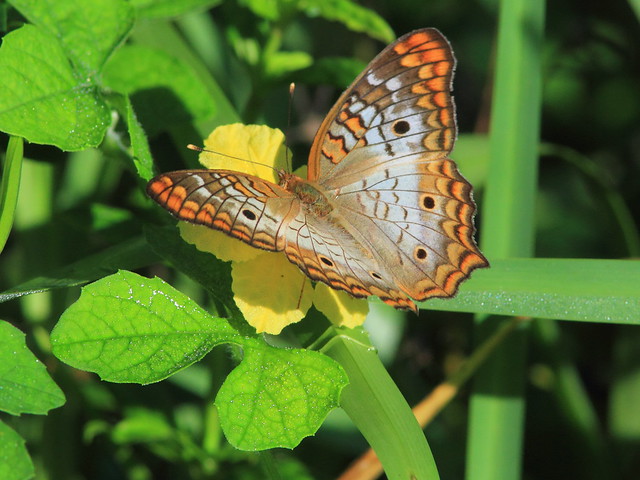
= = = = = = = = = = = = = = =
Linking to Misty's CAMERA CRITTERS,
Linking to Eileen's SATURDAY'S CRITTERS,
Linking to GOOD FENCES by Tex (Theresa).
Linking to WEEKEND REFLECTIONS by James
Linking to BirdD'Pot by Anni
Linking to Wild Bird Wednesday by Stewart
Linking to I Heart Macro by Laura
________________________________________________
Please visit the links to all these memes to see some excellent photos on display
________________________________________________
Hello ken, the Palm Warblers are so pretty. Lovely sky shots. Happy Thursday, enjoy your day and the week ahead!
ReplyDeleteOh my goodness, these are so beautiful. My favorite is the warbler with the grub in its beak.
ReplyDeleteI'm looking forward to the return of the palm warblers to Ontario!
ReplyDeletebeautiful skies. you can keep those gators! :) lovely warblers and grasses.
ReplyDeletebeautiful set of photos...watch out for those gators...we camped down in the everglades, such a special place!
ReplyDeleteGreat shots. Love the one you captured getting breakfast!
ReplyDeleteHello Kenneth!:) It is a joy to see all the great birds and landscapes you photograph. Lovely captures of the Warbler, and it was interesting to learn about the Alligater Flag plant.
ReplyDeleteBeautiful photographs of all the Warblers. First shot is stunning.
ReplyDeleteThese are just spectacular!
ReplyDeleteWhat a sweet looking bird the Palm Warbler is. Love those long legs. That was a good sized grub, can't say I'd want to eat one though. Very enjoyable post.
ReplyDeleteAwesome photos
ReplyDeleteI did not know that alligators carved out areas. And that little warbler is a cutie with his touch of yellow - especially notable in the photo when he is on the branch.
ReplyDeleteWas oohing and aahing while scrolling down. Great photos.
ReplyDeleteSuch awesome photos...love the sky shots, and some of your bird photos look like something that would be done in a painting. Really awesome.
ReplyDeleteBeautiful sky shots, and love the alligator photo!
ReplyDeleteFantastic sky
ReplyDeleteBeautiful butterfly, amazing images!
ReplyDeleteJust gorgeous!
ReplyDeleteMagnifque endroit et animaux ;o)
ReplyDeleteLovely series of photos..love the little warblers
ReplyDeleteInteresting to read how the alligators help with diversity - was reading a similar article about beaver ponds yesterday. So many connections.
ReplyDeleteCheers - Stewart M - Melbourne
Hello, gorgeous birds and photos. Thank you for linking up and sharing your post. Have a happy weekend!
ReplyDeleteWow! Great set of photos!
ReplyDeleteBeautiful birds!
ReplyDeleteHave a great week-end!
Lea
Love 'em all...your photos never cease to amaze me.
ReplyDeleteI'd never heard of alligator flags before. I learned something.
A special thanks for sharing and adding your post to the linking tool this weekend at I'd Rather B Birdin'!! Your contribution is always appreciated.
A very interesting post, like both the warblers and the alligators.
ReplyDeleteYour yellow warbler photos are just wonderful! What a fascinating and lovely little bird. It bit off more than it could "chew" with that grub! :-) Loved the info on the different wild grasses in FL and also the butterfly shot. Great post.
ReplyDeleteReally nice photos! I wonder how that bird is going to swallow that grub!
ReplyDeleteExcellent series Ken… I loved how your curiosity allowed you to learn something new about why the birds were hanging around the flowers. Thanks so much for sharing the love up-close with I Heart Macro ♥
ReplyDeleteA delightful series of photos. I remember spotting a palm warbler near a palm tree in the Everglades and it took me a while to identify him. Lovely little bird! Your grasses and alligator photos show how everything is connected in some way. Thanks so much, a great post!
ReplyDeleteWhat an amazing collection of images!
ReplyDelete